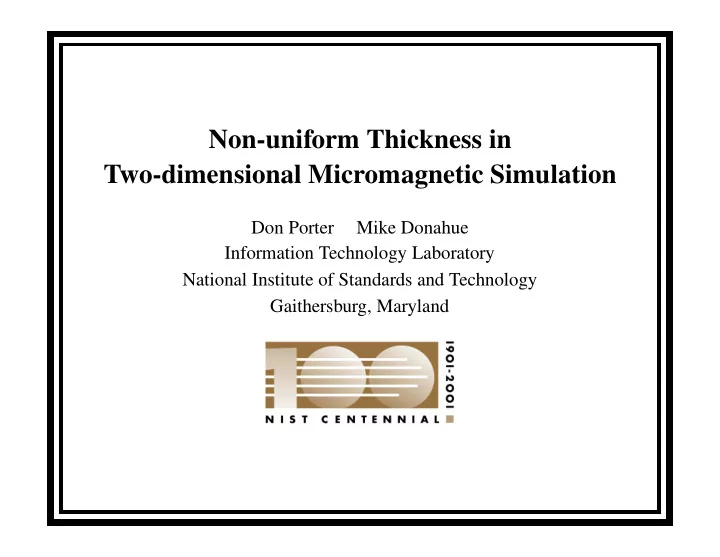

Non-uniform Thickness in Two-dimensional Micromagnetic Simulation Don Porter Mike Donahue Information Technology Laboratory National Institute of Standards and Technology Gaithersburg, Maryland
� Fewer cells � Less memory required 2D Model Advantages � Shorter calculation time � Simpler expressions – fewer bugs � Easier to visualize and interpret � Availability
� No variation through thickness � Limited to thin films 2D Model Shortcomings � Limited to single layers � Limited to uniform thickness - Why?
� For each cell k , store a relative thickness 0 � t � 1 2D Model with Variable Thickness k � Absolute thickness: 0 � t t � t k max max � Energy terms: Zeeman, anisotropy, exchange, magnetostatic � Adjust each field expression d M � = � j � j M � H � M � M � H dt M s � Adjust each energy expression � Retain 2D advantages
� Energy density and field unchanged E = � � M � H Zeeman Energy k ; Z 0 k k ; Z � Energy reduced by reduction in volume X 2 E � t t k ; Z k max k
� Energy density and field unchanged 2 K 1 Anisotropy Energy (uniaxial) H = ( M � u ) u k ; A 2 � M 0 s � Energy reduced by reduction in volume X 2 � � M � H � t t 0 k k ; A k max k
� Original expression (eight-neighbor cosine) X A Exchange Energy E = m � ( m � m ) k ; ex h k k l 2 3� l 2 N k � Each term: exchange energy between cells k and l � Adjust energy density by relative thickness of both cells: X A w ( t ; t ) k l E = m � ( m � m ) k ; ex h k k l 2 3� t k l 2 N k � Total exchange energy: X X At max E = m � w ( t ; t )( m � m ) ex h k k l k l 3 k l 2 N k
� Weights should have these properties w ( t ; t ) = w ( t ; t ) Exchange Energy Thickness Weighting 1 2 2 1 w ( t; t ) = t min ( t ; t ) � w ( t ; t ) � max ( t ; t ) 1 2 1 2 1 2 lim w ( t ; t ) = 0 1 2 t ! 0 2 � Candidate weight functions: w ( t ; t ) = min ( t ; t ) 1 2 1 2 2 t t 1 2 w ( t ; t ) = 1 2 t + t 1 2
� Uniform thickness: Grid is periodic � Demagnetization field is convolution of magnetization. Magnetostatic Energy � Efficient FFT techniques available � Variable thickness: efficient structure lost � Preserve efficiency: represent reduced thickness as reduced moment. M ! M t k k k
� Moment reduction good “far-field” approximation. � Self-demagnetization energy of a cell need correction Magnetostatic Energy H = � D ( M t ) k k k � Change in moment interpreted as change in demag factors H = � ( t D ) M k k k ( t D ) = t 6 = 1 k k � Local correction, add � (1 � t ) M k k ; z trace as a correction to the out-of-plane demag field.
� Represent a 100 � 100 � 10 nm oblate ellipsoid with three models Magnetostatic Energy Adjustment Results – 2D uniform thickness � Cell size 1 nm for all. – 2D with variable thickness adjustments � Check how well each produces uniform demag field. – 3D using 10 layers � Check calculated demag factors – In-plane: 0.0696 – Out-of-plane: 0.8608
2D Uniform Thickness � In-plane: 0.1026 � Out-of-plane: 0.7947
2D Variable Thickness � In-plane: 0.0635 � Out-of-plane: 0.8730
3D With 10 Layers � In-plane: 0.0753 � Out-of-plane: 0.8559
� Compare magnetic reversal of three permalloy samples 500 � 100 � 10 nm (Std. Prob. 2, d=l � 19 ) Shape Effects on Reversal 530 � 130 � 10 nm 530 � 130 ; top: 500 � 100 nm – � Reversal along [1 1 1] axis – – truncated pyramid, base:
530 x 130 Reversal
Magnetization Reversal Curves Effect of size, edge taper on reversal 1 Mx/Ms My/Ms −1 −40 0 Bx (mT)
Truncated Pyramid Reversal
� 530 � 130 � 10 nm sample Comparison of 2D and 3D Results H � 25 : 5 mT s – 2D variable thickness model H � 24 : 5 mT s � Truncated pyramid sample – 3D model – 5 layers H � 21 : 5 mT s – 2D variable thickness model H � 22 : 5 mT s – 3D model – 5 layers
Recommend
More recommend